Timeline of Braunschweig
The following is a timeline of the history of the city of Braunschweig (Brunswick), Germany.
Part of a series on the |
||||||||||
|---|---|---|---|---|---|---|---|---|---|---|
| History of Germany | ||||||||||
 | ||||||||||
| Topics | ||||||||||
| Early history | ||||||||||
| Middle Ages | ||||||||||
| Early Modern period | ||||||||||
| Unification | ||||||||||
| German Reich | ||||||||||
|
||||||||||
| Contemporary Germany | ||||||||||
|
||||||||||
|
| ||||||||||
Prior to 19th century
- 861 - According to legend, Braunschweig founded by Bruno of Saxony.[1]
- 955 - Area of city expanded.[2]
- 1031 - St. Magni (Braunschweig) church consecrated.[1]
- 1145 - Riddagshausen Abbey founded.
- 1160s - Henry the Lion makes Braunschweig his residence.
- 1166 - Brunswick Lion statue created.[3]
- 1175 - Dankwarderode Castle built.
- 1188 - Gospels of Henry the Lion created.
- 1190s - St. Martini (Braunschweig) church construction begins.[1]
- 1194 - Brunswick Cathedral built.[1]
- 1194 - 6 August: Henry the Lion dies.
- 1200s
- St. Katharinen (Braunschweig) church construction begins.
- Braunschweig joins the Hanseatic League.[4]
- Schoduvel (carnival) is celebrated.[5]
- 1245 - Großes Waisenhaus BMV (nursing home and orphanage) established.
- 1293–94 - Schicht der Gildemeister (civil unrest)
- 1304 - Bartholomäuskapelle (Braunschweig) on Schützenstraße (Braunschweig) first mentioned.
- 1307 - Gewandhaus (Braunschweig) guildhall/exchange first mentioned.
- 1312 - Rüningen gristmill first mentioned.
- 1370s - Große Schicht (civil unrest)
- 1390
- Public clock installed (approximate date).[6]
- Brunswick Mum is sold.
- 1396 - Altstadtrathaus (Braunschweig) (city hall) building expanded.[7]
- 1408 - Altstadtmarktbrunnen (fountain) installed in the Altstadtmarkt (Braunschweig).[7]
- 1410s
- Liberei (library) built.
- Braunschweiger Pfaffenkrieg (conflict between city council and churches)
- 1411 - Faule Mette cannon created.
- 1415 - Martino-Katharineum Braunschweig secondary school established.
- 1420 - St. Andreas (Braunschweig) church built (approximate date).[1]
- 1432 - The Princes of Brunswick-Wolfenbüttel move their Residenz from Braunschweig to Wolfenbüttel.[8]
- 1434 - Aegidienkirche (church) built (approximate date).[1]
- 1445–46 - Schicht der „ungehorsamen Bürger“ (civil unrest)
- 1451 - Brüdernkirche (Braunschweig) (church) built.[1]
- 1487–89 - Ludeke Hollants Schicht (civil unrest)
- 1498 - Braunschweiger Messe (fair) established.[3]
- 1509 - Printing press in operation.[9]
- 1520s - Protestant Reformation in Braunschweig.
- 1524 - Huneborstelsches Haus built.[3]
- 1531–32 - Braunschweig joins Schmalkaldic League.
- 1534 - Alte Waage (Braunschweig) built.
- 1551 - Population: 16,192.
- 1567 - Haus zur Hanse built.
- 1573 - Veltheimsches Haus built on the Burgplatz (Braunschweig).[3]
- 1627 - Hofbrauhaus Wolters (brewery) established.
- 1643 - Ehemaliges Rüninger Zollhaus (customs house) built.[3]
- 1663 - Trial and execution of Anna Roleffes.
- 1671 - Siege of Braunschweig by Rudolph Augustus, Duke of Brunswick-Lüneburg
- 1690 - Opernhaus am Hagenmarkt (opera house and theatre) opens.[3]
- 1745
- Collegium Carolinum founded.[1]
- Braunschweigische Anzeigen newspaper in publication.
- 1753 - Brunswick Palace established as the new ducal residence.[7]
- 1754 - Herzog Anton Ulrich-Museum and Naturhistorisches Museum open.
- 1761 - First Battle of Ölper
- 1769 - Schloss Richmond (castle) built.
- 1772 - 13 March: Premiere of Lessing's play Emilia Galotti.
- 1773 - Population: 23,385.
- 1790s - Braunschweig fortifications dismantled (approximate date).[1]
- 1791 - Lange Brücke (Braunschweig) (bridge) rebuilt.
- 1799 - Friedrich Vieweg (publisher) moves to Braunschweig.
19th century
- 1806 - French in power; Braunschweig French period begins.
- 1807 - Wilhelm Albrecht Christian von Mahrenholtz becomes mayor.
- 1809 - 1 August: Second Battle of Ölper
- 1815 - Duchy of Brunswick established
- 1823 - Obelisk erected in the Löwenwall.
- 1829 - 19 January: Premiere of Goethe's play Faust, Part One.
- 1830
- 1835 - Grotrian-Steinweg established.
- 1838 - Westermann Verlag (publisher) in business.
- 1838 - 1 December: First section of the Brunswick–Bad Harzburg railway line, connecting Braunschweig and Wolfenbüttel, opens.[11][12]
- 1843–44 - Hanover–Brunswick railway opens.
- 1844 - Rabbinical Conference of Brunswick
- 1847 - MTV Braunschweig established.
- 1848–49 - German revolution of 1848–49 in Braunschweig
- 1849 - Voigtländer sets up its office in Braunschweig.
- 1853 - Braunschweigische Bank active.[13]
- 1856 - Westermanns Monatshefte (magazine) headquartered in Braunschweig.
- 1860 - Braunschweig City Archive established.[14]
- 1861
- Staatstheater Braunschweig (theatre) opens.
- Stadtbibliothek Braunschweig (library) and Städtisches Museum (Braunschweig) founded.
- 1863 - Braunschweiger Quadriga sculpture erected atop the palace.
- 1871
- Braunschweiger Volksfreund newspaper in publication.
- Feldschlößchen (Braunschweig) brewery in business.
- Population: 57,883.[15]
- 1872 - Brunswick–Magdeburg railway begins operating.
- 1874 - Konrad Koch introduces football to Germany.[16]
- 1875 - 23 September: Neue Synagoge (Braunschweig) opens.
- 1879 - Trams in Braunschweig begin operating.
- 1880 - Population: 75,038.[17]
- 1885 - Population: 85,174.[18]
- 1887 - Hauptfriedhof Braunschweig (cemetery) established.
- 1890 - Population: 101,047.[19]
- 1891 - Braunschweigisches Landesmuseum founded.
- 1894–1900 - New Braunschweiger Rathaus (city hall) built.
- 1895
- Eintracht Braunschweig football club and Jüdischer Friedhof (Braunschweig) (cemetery) established.
- Wilhelm Scholz bookseller in business.
- Population: 115,138.[20]
20th century
1900–1945
- 1901 - Braunschweigischer Geschichtsverein (historical society) founded.
- 1903 - Büssing established.
- 1906 - Dankwarderode Castle reconstructed.
- 1907 - Panther Fahrradwerke (bicycle manufactory) in business.[3]
- 1909 - 21 April: Gymnasium Gaussschule established.
- 1913 - 24 May: Marriage of Ernest Augustus, Duke of Brunswick and Princess Victoria Louise of Prussia.[21]
- 1918
- November Revolution in Braunschweig occurs.[3]
- 8 November: Ernest Augustus forced to abdicate.[22][23]
- 10 November: Socialist Republic of Brunswick proclaimed.
- 10 November: Free State of Brunswick established.
- 1919
- 9 April: Spartacus League uprising.
- 13–17 April: State of emergency declared, Freikorps troops enter city.[24][25]
- Population: 139,539.[26]
- 1920 - Rollei established.
- 1923 - 17 June: Eintracht-Stadion opens.
- 1929 - Deutsche Verkehrsfliegerschule moved to Broitzem.
- 1931
- 1933 - Mittelland Canal reaches Braunschweig.
- 1934
- Gliesmarode, Lehndorf (Braunschweig), Melverode, Ölper, Querum, Riddagshausen, and Rühme are incorporated into the city of Braunschweig.
- Population: 166,823.
- 1935 - SS-Junkerschule Braunschweig established.[28]
- 1936
- Luftfahrtforschungsanstalt in Völkenrode built.
- Braunschweig Airport opens.
- 1938
- Niedersächsische Musikschule Braunschweig (formerly Brunswick State Conservatoire) established.
- 23 February: Volkswagenwerk Braunschweig starts production.
- 9–10 November: Kristallnacht in Braunschweig.
- 1939
- Nazi Academy for Youth Leadership built.[29]
- Population: 208,400.
- 1940
- Synagogue demolished.
- Bombing of Braunschweig in World War II begins.
- 1943 - Entbindungsheim für Ostarbeiterinnen established.[30]
- 1944 - 17 August: KZ subcamp Schillstraße established.
- 1945 - 12 April: Surrender of Braunschweig.
1946–1999
- 1946 - Braunschweiger Zeitung (newspaper) begins publication.
- 1947 - Physikalisch-Technische Bundesanstalt refounded in Braunschweig.
- 1949
- Abendgymnasium Braunschweig (school) established.
- Antiquariat am Burgplatz bookshop in business.
- 1955 - 1 February: Luftfahrt-Bundesamt opens.
- 1960
- Brunswick Palace demolished.
- Building of the Weststadt starts.[31]
- 1 October: Braunschweig Hauptbahnhof opens.
- 1963 - Hochschule für Bildende Künste Braunschweig established.
- 1971 - Fachhochschule Braunschweig/Wolfenbüttel established.
- 1972 - Braunschweiger Verkehrs-AG (public transit entity) active.
- 1974 - 28 February: District of Braunschweig disestablished and its main part incorporated into the city of Braunschweig.
- 1975 - Population: 269,900.
- 1976 - Gerhard Glogowski becomes mayor.
- 1977 - Federal Agricultural Research Centre established.
- 1982 - Gerstäcker-Museum established.
- 1987 - Deutsche Sammlung von Mikroorganismen und Zellkulturen moves to Braunschweig.
- 1988 - Braunschweig Classix Festival established.
- 1991–94 - Reconstruction of Alte Waage.
- 1994 - Sparkassen Open tennis tournament established.
- 1998 - 1 September: German Federal Bureau of Aircraft Accident Investigation established.[32]
- 2000
- Wilhelm Raabe Literature Prize established.
- 20 September: Volkswagen Halle opens.
21st century
- 2001 - Happy Rizzi House built in the Ackerhof.
- 2006 - 6 December: Synagoge (Braunschweig) opens.
- 2007 - 6 May: Rebuilt Brunswick Palace opens.
- 2010 - RegioStadtBahn Braunschweig light rail project cancelled.
- 2013 - Population: 247,227.
- 2014 - Ulrich Markurth becomes mayor.
Images
.jpg.webp) Braunschweig on the Ebstorf Map, circa 1300
Braunschweig on the Ebstorf Map, circa 1300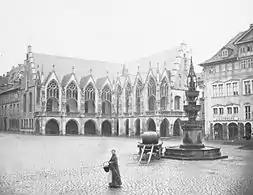 City Hall and fountain, installed 1408 (photo circa 1865)
City Hall and fountain, installed 1408 (photo circa 1865).JPG.webp) Braunschweig in 1492
Braunschweig in 1492 Braunschweig in the 16th century, from the Civitates orbis terrarum by Georg Braun and Frans Hogenberg.
Braunschweig in the 16th century, from the Civitates orbis terrarum by Georg Braun and Frans Hogenberg..jpg.webp) Braunschweig in 1550.
Braunschweig in 1550.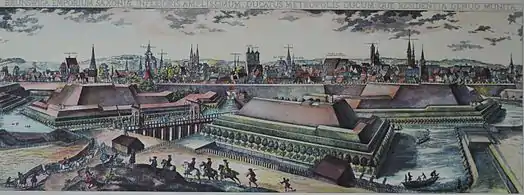 Braunschweig in 1610.
Braunschweig in 1610.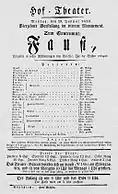 Programme for premiere of Goethe's Faust, 1829
Programme for premiere of Goethe's Faust, 1829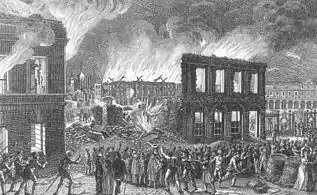 Brunswick Palace set on fire, 7 September 1830
Brunswick Palace set on fire, 7 September 1830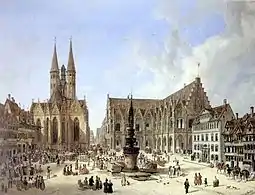 Altstadtmarkt in 1834, by Domenico Quaglio the Younger.
Altstadtmarkt in 1834, by Domenico Quaglio the Younger.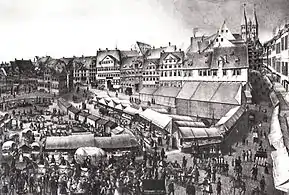 Fair in 1840.
Fair in 1840. Kohlmarkt in 1894.
Kohlmarkt in 1894.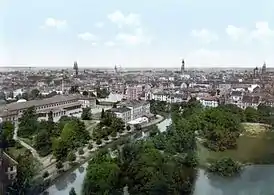 Braunschweig around 1900.
Braunschweig around 1900. Braunschweig on the night of 15 October 1944
Braunschweig on the night of 15 October 1944.JPG.webp) Braunschweig in 2011.
Braunschweig in 2011.
See also
- Braunschweig history
- History of Braunschweig
- List of mayors of Braunschweig
Other cities in the state of Lower Saxony:(de)
References
- Britannica 1910.
- Overall 1870.
- "Stadtgeschichte: Stadtchronik Braunschweig" [City History: Chronology of Braunschweig] (in German). Stadt Braunschweig. Retrieved 30 November 2015.
- Moderhack, Richard (1997). Braunschweiger Stadtgeschichte (in German). Braunschweig: Wagner. pp. 50–52. ISBN 3-87884-050-0.
- Søndergaard, Leif. "Carnival is Festival: Dances as Entertainment". Retrieved 8 October 2012.
- Gerhard Dohrn-van Rossum (1996). History of the Hour: Clocks and Modern Temporal Orders. University of Chicago Press. ISBN 978-0-226-15510-4.
- Baedeker 1910.
- Moderhack 1997, pp. 60–69
- Henri Bouchot (1890). "Topographical index of the principal towns where early printing presses were established". In H. Grevel (ed.). The book: its printers, illustrators, and binders, from Gutenberg to the present time. London: H. Grevel & Co.
- Gerhard Schildt: Von der Restauration zur Reichsgründungszeit, in Horst-Rüdiger Jarck / Gerhard Schildt (eds.), Die Braunschweigische Landesgeschichte. Jahrtausendrückblick einer Region, Braunschweig 2000, pp. 753–766
- E. Oppermann (1911): Landeskunde des Herzogtums Braunschweig. Geschichte und Geographie. Braunschweig: E. Appelhans, p. 64.
- Neubauer, Jürgen / Salewsky, Dieter (1988): 150 Jahre 1. Deutsche Staatseisenbahn Braunschweig-Wolfenbüttel. Braunschweig: Joh. Heinr. Meyer Verlag. ISBN 3-926701-05-6.
- "Germany". International Banking Directory. New York: Bankers Publishing Company. 1922.
- "Stadtarchiv: Geschichte des Archivs" (in German). Stadt Braunschweig. Retrieved 30 November 2015.
- "Germany: States of Germany: Brunswick". Statesman's Year-Book. London: Macmillan and Co. 1873.
- Ciarán Fahey (19 June 2014). "Fußball: The History of a German Obsession". Societäts-Medien. Retrieved 1 July 2015.
- "Germany: States of Germany: Brunswick". Statesman's Year-Book. London: Macmillan and Co. 1883.
- "German Empire: States of Germany: Brunswick". Statesman's Year-Book. London: Macmillan and Co. 1890.
- "German Empire". Statesman's Year-Book. London: Macmillan and Co. 1894.
- "German Empire". Statesman's Year-Book. London: Macmillan and Co. 1899 – via HathiTrust.
- Henning Steinführer, Gerd Biegel (eds.): 1913 – Braunschweig zwischen Monarchie und Moderne. Appelhans Verlag, Braunschweig 2015, ISBN 978-3-944939-12-4.
- Moderhack 1997, pp. 193–194
- Rother 1990, pp. 27–30
- Rother 1990, pp. 67–72
- Hans-Ulrich Ludewig (2000): Der Erste Weltkrieg und die Revolution (1914–1918/19), in: Horst-Rüdiger Jarck / Gerhard Schildt (eds.), Die Braunschweigische Landesgeschichte. Jahrtausendrückblick einer Region, Braunschweig 2000, pp. 935–943
- "Germany". Statesman's Year-Book. London: Macmillan and Co. 1921.
- Rother 1990, p. 244
- "Braunschweiger Schloss / SS-Junkerschule". Vernetztes-gedaechtnis.de. Retrieved 24 July 2015.
- "Akademie für Jugendführung". Vernetztes-gedaechtnis.de. Retrieved 24 July 2015.
- "Entbindungsheim für Ostarbeiterinnen". Vernetztes-gedaechtnis.de. Retrieved 12 July 2015.
- Braunschweig-Weststadt - größtes Wohnbauprojekt in unserer Region (in German). Retrieved on 3 September 2017.
- "Organizations". International Relations and Security Network. Switzerland: Eidgenössische Technische Hochschule Zürich. Retrieved 30 November 2014.
This article incorporates information from the German Wikipedia.
Bibliography
in English
- Abraham Rees (1819), "Brunswick", The Cyclopaedia, London: Longman, Hurst, Rees, Orme & Brown
- Edward Augustus Domeier (1830), "Brunswick", Descriptive Road-Book of Germany, London: Samuel Leigh
- William Henry Overall, ed. (1870). "Brunswick". Dictionary of Chronology. London: William Tegg.
- "Brunswick", Northern Germany (15th ed.), Leipzig: Karl Baedeker, 1910, OCLC 78390379
- "Brunswick", Encyclopædia Britannica (11th ed.), New York, 1910, OCLC 14782424 – via Internet Archive
- John M. Jeep, ed. (2001). "Braunschweig". Medieval Germany: an Encyclopedia. Garland Publishing. ISBN 0-8240-7644-3.
in German
- "Braunschweig: Die Stadt". Biblioteca geographica: Verzeichniss der seit der Mitte des vorigen Jahrhunderts bis zu Ende des Jahres 1856 in Deutschland (in German). Leipzig: Wilhelm Engelmann. 1858 – via Google Books. (bibliography)
- Braunschweig. Die Chroniken der Deutschen Städte (in German). 6, 16, 35. Leipzig: S. Hirzel Verlag. 1868–1928 – via HathiTrust.
- Hermann Adalbert Daniel (1878). "Das Herzogthum Braunschweig". Handbuch der Geographie (in German) (5th ed.). Leipzig: Fues's Verlag.
- Karl von Hegel (1891). "Braunschweig". Städte und Gilden der germanischen Völker im Mittelalter (in German). 2. Leipzig: Duncker & Humblot – via HathiTrust.
- "Braunschweig". Brockhaus' Konversations-Lexikon (in German) (14th ed.). Leipzig: Brockhaus. 1896.
- P. Krauss und E. Uetrecht, ed. (1913). "Braunschweig". Meyers Deutscher Städteatlas [Meyer's Atlas of German Cities] (in German). Leipzig: Bibliographisches Institut.
- Rother, Bernd (1990). Die Sozialdemokratie im Land Braunschweig 1918 bis 1933 (in German). Bonn: Verlag J. H. W. Dietz Nachf. ISBN 3-8012-4016-9.
- Braunschweiger Stadtlexikon (in German), 1992
External links
| Wikimedia Commons has media related to Braunschweig. |
- Links to fulltext city directories for Braunschweig via Wikisource
This article is issued from Wikipedia. The text is licensed under Creative Commons - Attribution - Sharealike. Additional terms may apply for the media files.